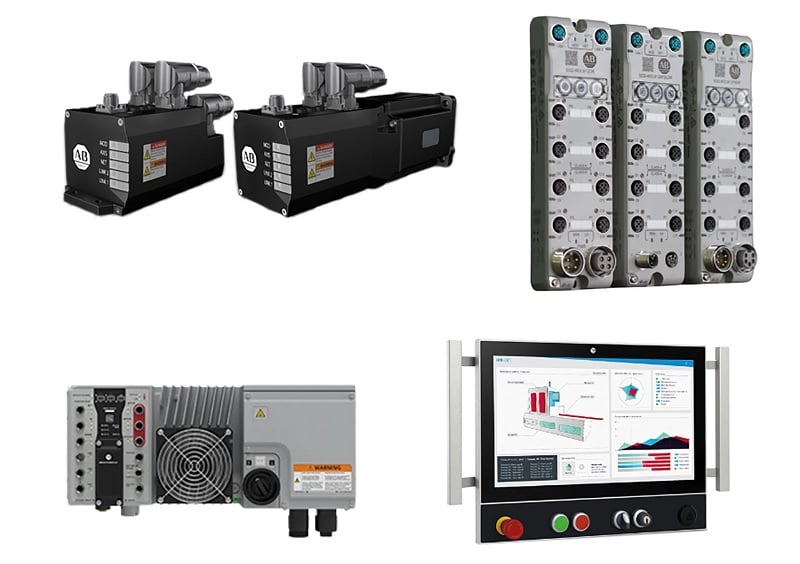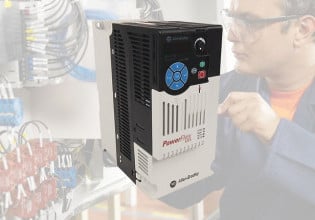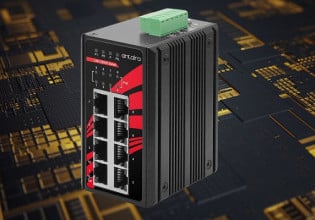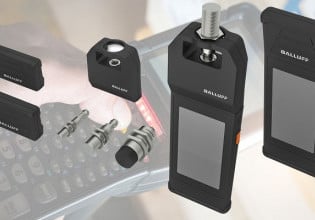Rockwell’s Newest On-Machine Devices Speed Engineering Development
Creating a decentralized control system means selecting devices that can withstand harsh environments. New offerings in the Armor product line from Rockwell Automation are doing just that.
In the not-so-distant past, machine builders were forced to place their servo drives, I/O modules, and any PCs within an electrical cabinet. This design structure resulted in large cabinets with many cables that ran out to field devices. The new design is to mount these devices in the field, resulting in shorter cables (if signal cables must be used at all) and smaller control cabinets. These devices must withstand the sometimes harsh environments and be capable of running on low voltage.
On-Machine Technology from Rockwell
Recently, Rockwell Automation has released components capable of being field mounted, focusing on the development of components that will assist machine builders in getting to market faster.

Several of Rockwell’s newest products in the Armor lineup. Image used courtesy of Rockwell Automation
On-Machine Solutions
Rockwell's complete product line of automation components is quite extensive, but when looking for On-Machine solutions, you will find a much shorter list of components. This is because it takes many years of engineering and design to develop these devices.
Rockwell has highlighted the selection of the most recent additions to the on-machine device portfolio.
ArmorKinetix Servo Drive
Servo drives can take up a lot of real estate within a control cabinet, and the cables required to transmit the electrical signals to the servo motors can be bulky and expensive. The ArmorKinetix distributed servo drive is built on the existing Kinetix 5700 system and is IP66/67 rated. The ArmorKinetix can be mounted in the field next to or near the servo motors, and since it is built on the 5700 platform the control logic will be similar.
ArmorBlock I/O Module
When sensors are mounted in the field, it just makes logical sense that the I/O modules be mounted near the sensors as well. With the ArmorBlock, designers can build modular equipment with I/O modules mounted near the sensor or actuators. Machines can be broken into sections based on I/O functions, then multiple sections can be combined with the use of industrial networks.

ArmorBlock machine-mountable I/O devices. Image used courtesy of Rockwell Automation
Armor PowerFlex VFD
The popular PowerFlex VFD product line is a series of variable-frequency drives that are popular with conveyors, fans, and pumping applications. Similar to servo drives, VFDs can take up quite a bit of space and require large cables. Mounting your VFD next to the motor not only reduces cabling but also can aid in troubleshooting because maintenance staff won't have to hunt for the problematic drive.

Rockwell’s Armor PowerFlex VFD. Image used courtesy of Rockwell Automation
On-Machine Industrial PC
Dedicated HMIs may soon become a thing of the past as more machine builders today turn to a panel PC for their HMI needs. But you don’t want to use just any PC, you want to make sure the PC is of industrial grade. The 6300PA from Rockwell is a fanless industrial PC designed to withstand many temperature ranges and provide years of service.
Decentralized Control Structures
A common design practice is to have one main control cabinet that houses a PLC, VFDs, servo drives, and I/O modules. On a large assembly line, this cabinet can become quite large and take up a lot of space on the manufacturing floor.
A decentralized control structure is where you move the control devices to sections of the machine or even in the field directly. So instead of one PLC responsible for all the logic, each zone of the equipment would have dedicated controllers and hubs performing tasks suitable for that section. Instead of having one I/O module setup for the entire line, I/O blocks are placed in the field next to the sensor or actuators, and an industrial network can transmit those signals back to the main control system.
This distributed design allows engineers to develop more modular and flexible equipment that can be scaled up or down depending on the customer's requirements.






